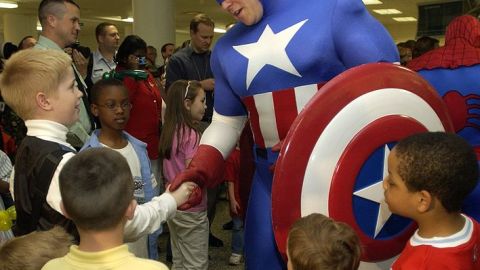Comics Introducing Children to the Classics

In an age where people would rather speculate as to which classic novels would make the best video game rather than, you know, actually read the books, teachers and parents are trying to endear the classics to young people. The answer, believe it or not, could come from the same bizarre world that showed us that men with capes and tights could save the world.
As an educational medium, comic books, specifically graphic novels, aren’t unprecedented. In fact, two of history’s most famous graphic novels might be in your local library. Art Spiegelman’s Pullitzer-Prize-winning Maus is history’s most-innovative re-telling of the Holocaust while Marjane Strapi’s Persepolis: the Story of a Childhood was published by Random House and provides an interesting perspective on growing up in Iran.
Most recently, Ray Bradbury’s Fahrenheit 451, the definitive book about book burning, was given a highly-successful graphic novel treatment in a move authorized entirely by Bradbury. In fact, Bradbury is so excited by the new take on his classic novel that two more of his works, Something Wicked This Way Comes and the Martian Chronicles, are also getting the comic book treatment. “There’s no difference between the novel and the illustrated novel,” Bradbury says on his publisher’s web site.
Fahrenheit illustrated has since become one of the top-selling paperback graphic novels while a series based on Stephen King’s The Stand is on the hardcover list. The trend to convert the classics into graphic form really began to take shape in 2006, when Lerner Publishing’s Graphic Myths and Legends series began printing titles like Beowulf, Hercules, and Tristan & Isolde. That same year, Stone Arch Books released its Graphic Revolve series with the explicit intention of getting children struggling with their reading into the classics by releasing illustrated versions of titles like The Invisible Man, The Legend of Sleepy Hollow, and Treasure Island.
The classics in comic form started as far back as the 1930s. Naturally, many of these classic illustrated retellings have been re-released by Papercuts through their historic Classics Illustrated series, which originally launched in 1941 with classic adaptations of Shakespeare, Verne, and Stevenson. Last year, Marvel, the comic book giant behind icons like Spiderman and X Men, released hardcover illustrated editions of the Iliad and Last of the Mohicans.
While H. G. Wells’ imaginative and groundbreaking works have been a natural fit for the comic book treatment, other publishers have adapted the works of classic novelists like Charles Dickens and Agatha Christie. So does it detract from the actual reading experience? It might not really matter. Besides, the video game version might not be far behind.





